After only one season in charge, Hernán Losada was sacked by the Canadian club at the end of the 2023 MLS season, one that ended with a 10th placed finish and failure to qualify for the MLS Cup playoffs. After a few months-long search, CF Montréal decided to hire former Columbus Crew 2 head coach Laurent Courtois.
The former West Ham United player came in having won the inaugural MLS NEXT Pro title with his former side in 2022 and guiding them to the final again last season. This tactical analysis will briefly examine some of the early tactics that are beginning to form for Courtois in Montréal and compare them to his time in Columbus with the Crew’s reserve team.
Preferred formation and setup
When looking at Montréal’s first two matches of the 2024 MLS season, we can see that Courtois has opted to set his side up in a 3-4-2-1 formation for both matches, with this shape something that the 45-year-old is most comfortable with deploying.
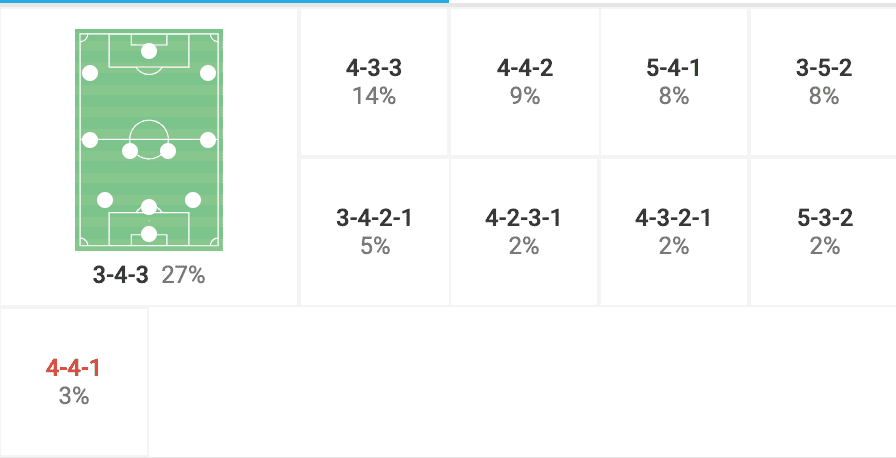
The image above shows the formations that the Frenchman tended to utilise during his time in charge of Columbus Crew 2 last season. As we can see, a back three system was also the most commonly used formation, with this shape tending to look very much like a 3-4-3 at the beginning of matches.
This is also similar to the system that Wilfried Nancy has implemented with the first team since his appointment at the club. With Courtois being a close friend of Nancy, it is unsurprising that there would potentially be similarities. Tactical similarities have also been noted, with a few of CF Montréal’s players in the offseason talking about how the style of play that Courtois had begun to implement was, in some ways, similar to when Nancy led the side to a second-placed finish in the Eastern Conference in 2022.
With all this being said, let us now take a deeper dive into the tactical trends that we have been able to notice from Courtois during CF Montréal’s first two matches of this brand-new Major League Soccer season and how they compare to his time with Columbus Crew 2 and Wilfried Nancy’s identity with the Columbus Crew senior team.
Promoting verticality and width in attacking moments
Looking first at the attacking shape and tendencies of CF Montréal from their first two matches of the season, we can see that a bit of an identity is beginning to show in how they are looking to progress the game forward. While it is only a small sample size, Courtois’s side currently have one of the lowest possession numbers in MLS, with a 42.7% average possession statistic. When Courtois was in charge of Columbus Crew 2 last season, the MLS NEXT Pro side averaged 50.8% over the course of the season, just barely over half.
So far with Montréal, the 45-year-old has looked for his side to progress the ball forward quickly, with an emphasis on verticality and overloading the opponent’s defensive line. In most attacking phases, Montréal’s attacking shape has tended to look like a 3-2-5 or even a 3-2-4-1, with the attacking five looking to overload the opposition defences and the wingbacks staying high and wide to look and stretch the opposition’s defence.
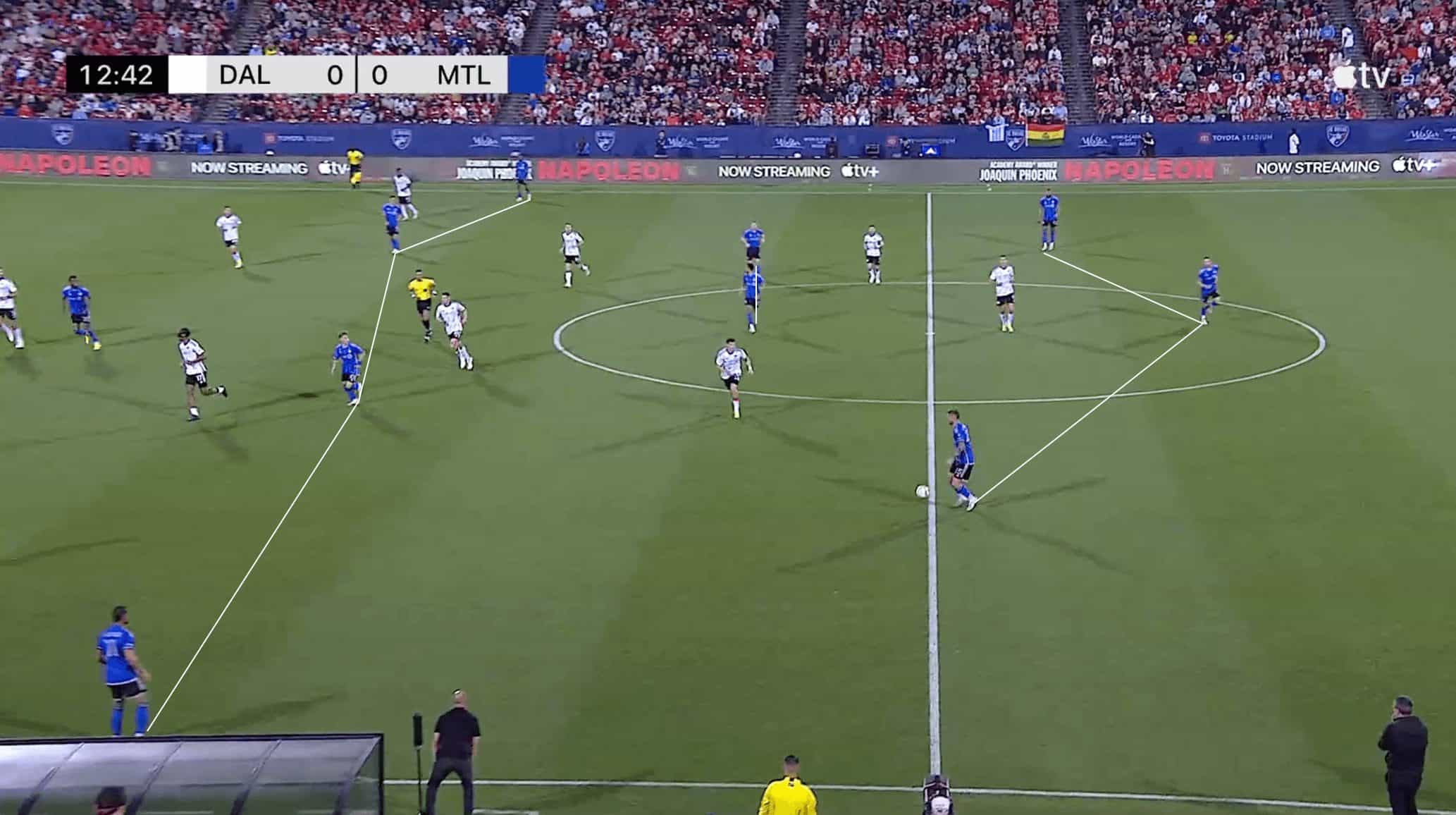
The image above shows this attacking shape from Laurent Courtois’s side, highlighting the 3-2-5 shape that his side has morphed into during attacking phases of play. In this phase of play, the ball is in possession of former Bologna centre-back Gabriele Corbo, with a double pivot of Samuel Piette and Mathieu Choinière sitting slightly advanced of the back three in a double pivot. Further forward, wingbacks Ariel Lassiter and Ruan keep the width and look to stretch the FC Dallas defensive shape, with Bryce Duke, Matías Cóccaro and Jules Vilsaint operating in more central positions. The width of this shape allows passing lanes to open up, with Montréal looking to progress the ball vertically on the ground throughout these first two matches.
As this passage of play progresses, Corbo can advance the game by dribbling into the attacking half, with the FC Dallas defensive line pinned back and unable to engage. The Italian central defender is then able to play a line-breaking pass into the run of Vilsaint, who flicks into the path of Duke to allow the attacking move to progress into the penalty area, with only three total passes needed to progress the game into this dangerous area, highlighting the verticality and quick ball progression that Courtois is looking to implement.
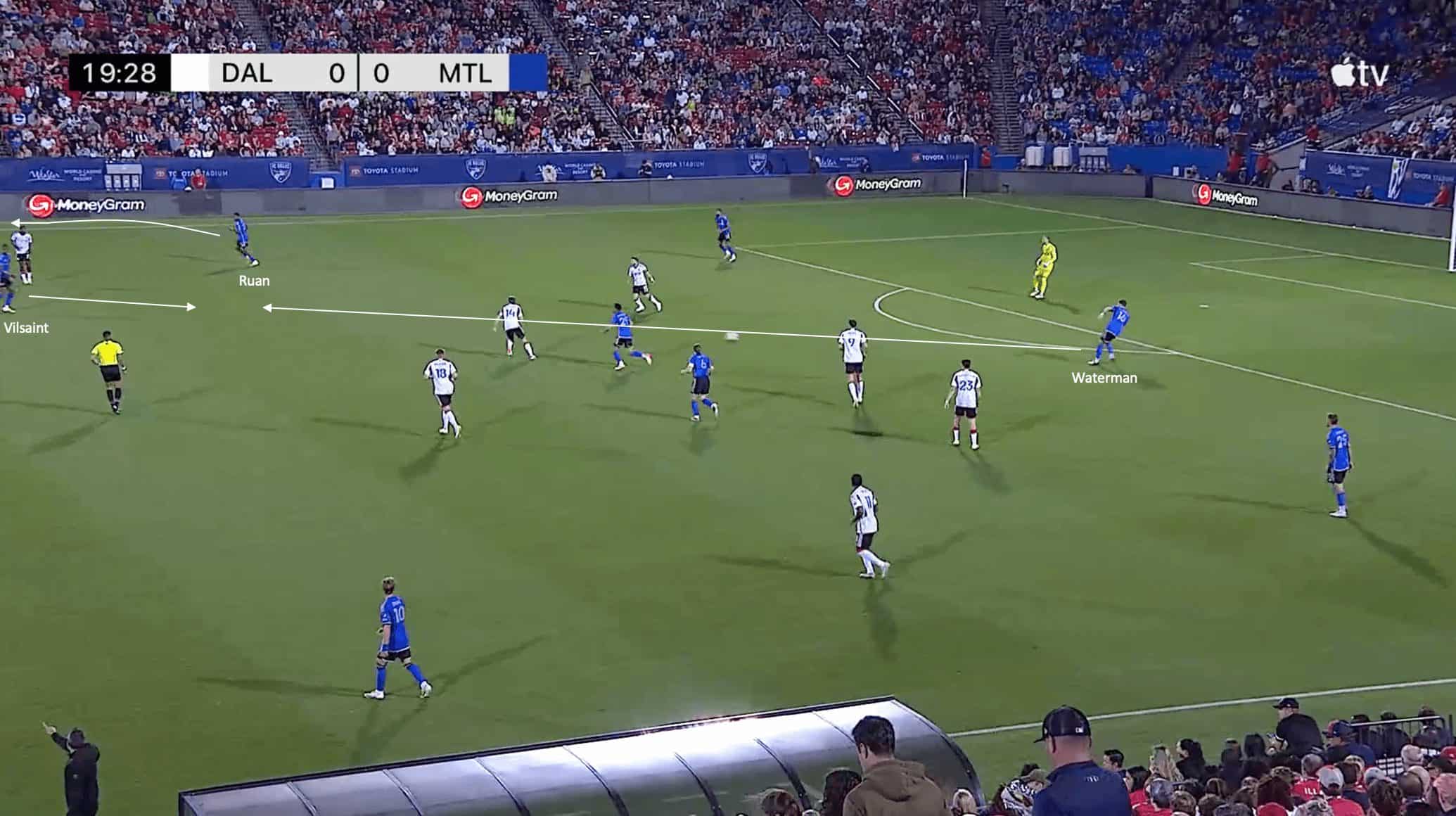
The above image shows the first part of the attacking phase that resulted in CF Montréal’s first goal against FC Dallas. The ball is currently in possession of the central centre-back, Joel Waterman, with Piette and Choinière just in front of them. This allows Montréal’s build-up shape to look like a five, which attracts more Dallas players to pressure the ball and look to win possession in an advanced area.
This allows gaps to form between the midfield and defensive lines for Dallas, with Jules-Anthony Vilsaint dropping into this pocket of space. Waterman spots the movement and plays a ground pass into the feet of Vilsaint, breaking both Dallas’s forward and midfield lines. Brazilian wing-back Ruan proceeds to make an advanced run, with Vilsaint able to turn while in possession and find the run of the Brazilian behind the Dallas defence.
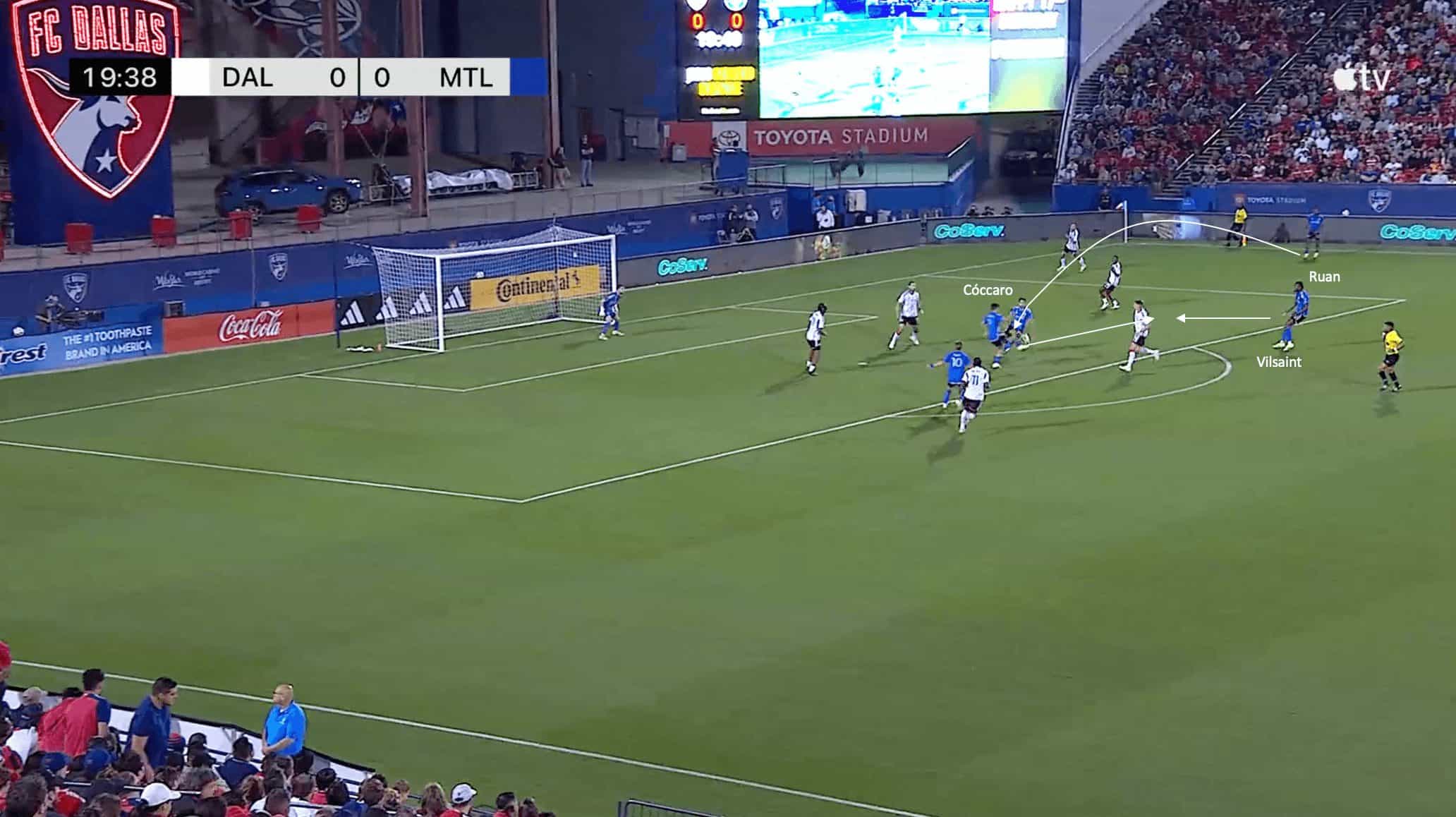
This image shows the second phase of the Montréal attack, once Laurent Courtois’s side reached the final third. After driving towards the endline, Ruan is able to play a cross into the penalty area, with a deft touch taken by Uruguayan forward Matías Cóccaro. This ball falls into the path of Vilsaint, who can fire the ball into the back of the net past Dallas goalkeeper Maarten Paes.
Again, an emphasis on verticality and quick ball progression leads to this goal, with a total of only four passes needed to get from Waterman in the defensive third all the way to the shot from Vilsaint.
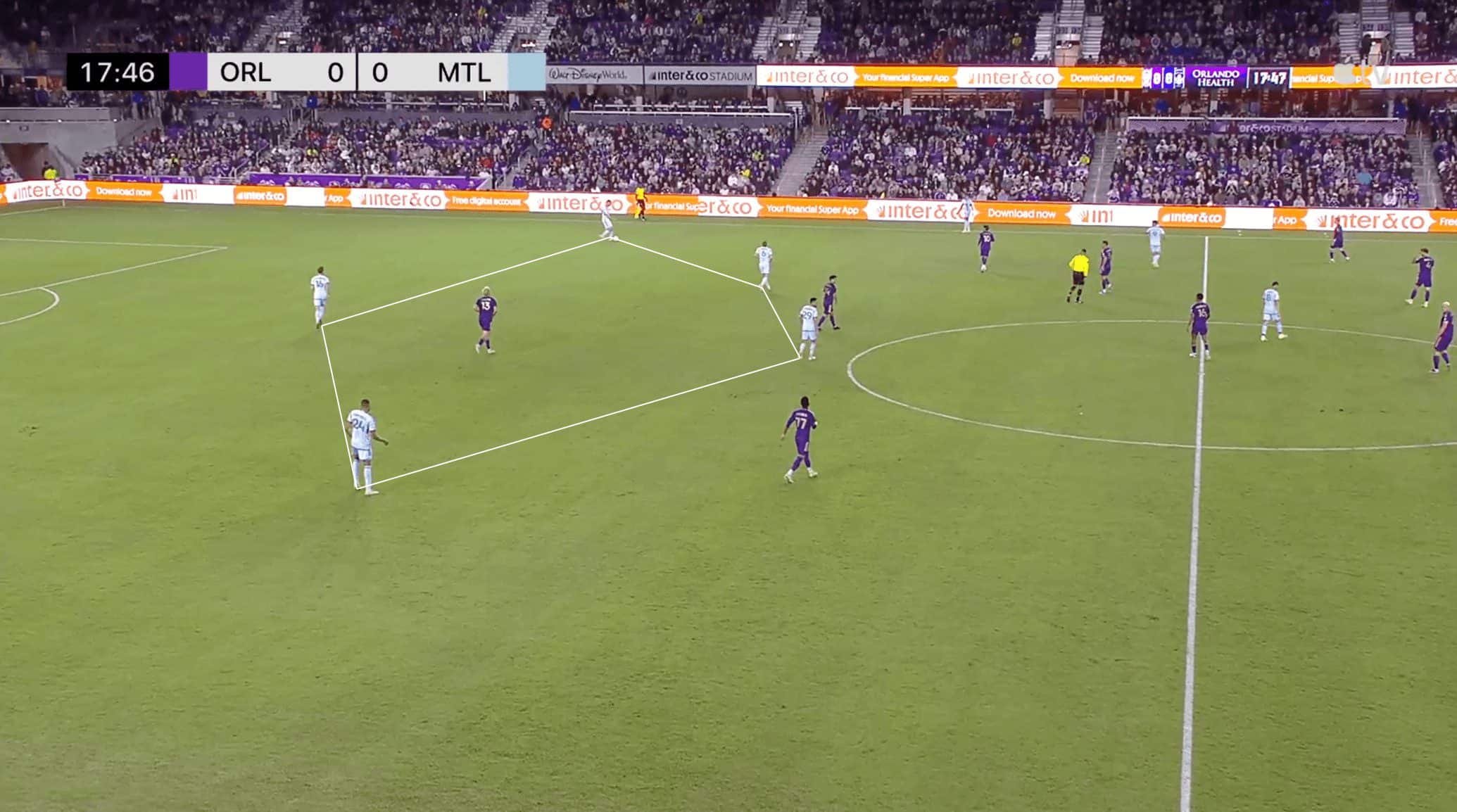
The image above again shows the shape that Montréal have looked to build in, with the back three and two deeper lying midfielders staying to build, while also offering a good defensive presence if the ball were to be turned over in the middle third. Another thing that this build-up shape does is frustrate the opposition, with it difficult for one or two forward players to win the ball back off the five.
As a result, opposition players tend to get impatient and be more aggressive, opening up gaps in advanced areas as they detach and look to engage. In this example, that occurs with one of the Orlando City midfielders deciding to press and engage the central defender. This opens up a passing lane, with the ball being played to a player sitting in a pocket who is subsequently fouled, allowing Montréal to relieve some pressure and start in a higher position.
Mid-to-low block defending
When watching CF Montréal’s first two matches of the new MLS season, you can see that at moments in matches, usually early on, the Canadian side look to be more aggressive and on the front foot in defensive moments, with their opening match against Orlando City a great example of this. However, through their first two matches of the new season, they have a PPDA of 15.72 and a challenge intensity of 3.9, showing that now, at least in the short-term, Laurent Courtois wants his side to be defensively compact and not concede many chances.
In both of their matches so far, Montréal have tended to defend in either a mid or low block, with the shape becoming a back five in defensive moments as the two wing backs drop and tuck into the defensive shape. This tends to make the defensive shape look like either a 5-3-2 or a 5-4-1 most times, though it has also looked like a 5-2-2-1 at times, with the box four in midfield preventing central progression for opposition sides.
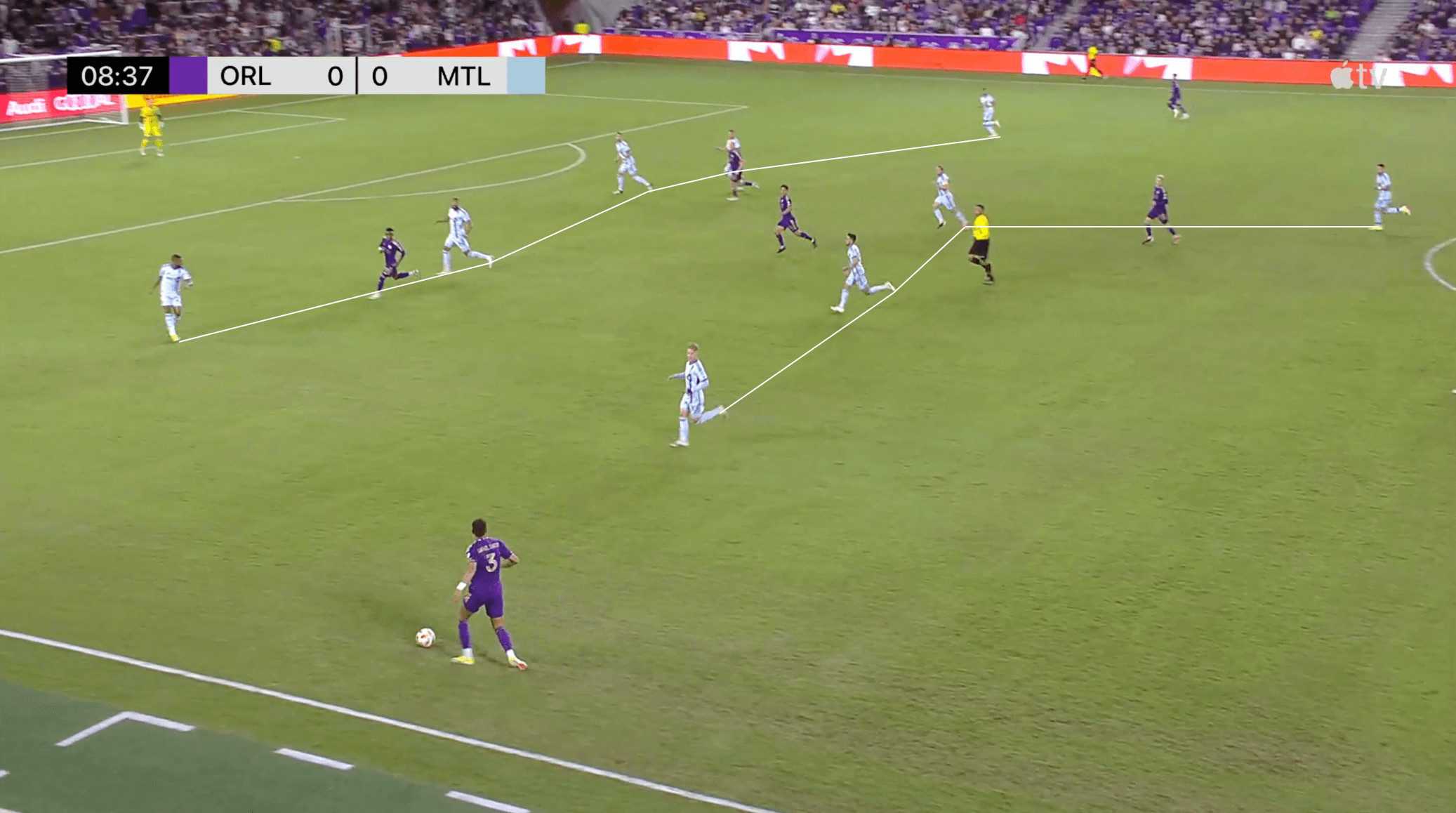
The image above shows the defensive shape that Montréal have tended to morph into once the opposition have reached the attacking half of the pitch. As we can see, in this phase above, Courtois’s side has dropped into something reminiscent of a 5-4-1 shape, with the central striker currently out of the picture inside the centre circle.
This compact shape prevented Orlando City the ability to have much central progression, with the majority of passes forced high and long or into the wide areas, two areas that Montréal were gladly able to give up instead of progression through the central areas.
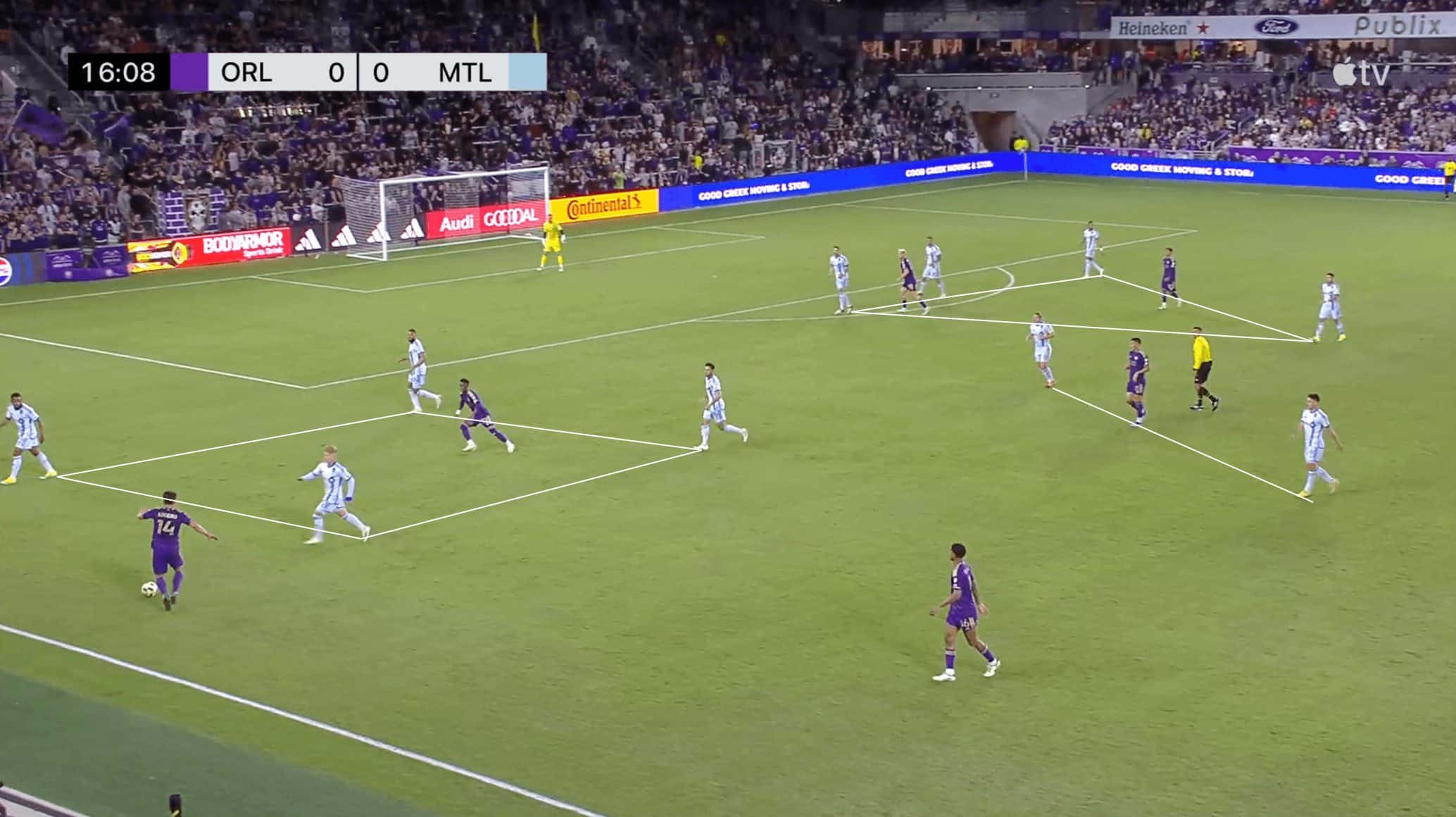
The image above shows another positive impact this compact and rigid defensive shape allowed Laurent Courtois’s side to have during their match against Orlando City in particular. As we can see, Montréal are again set up in a 5-4-1 defensive shape. Still, the vital thing to note here is the defensive overloads that this shape was able to create against the dynamic attacking threats that Orlando City possesses.
As this image’s annotations highlights, the Canadian side have formed a 4v2 defensive overload on this near touchline where the ball is currently located, a 2v1 against the free option centrally, and another 4v2 near the edge of the penalty area. This defensive superiority did not allow much space for Orlando City to create chances, with this particular phase of play ending with Montréal being able to clear the danger after the home side attempted to switch the play a couple more times to try and draw the CF Montréal defensive shape out.
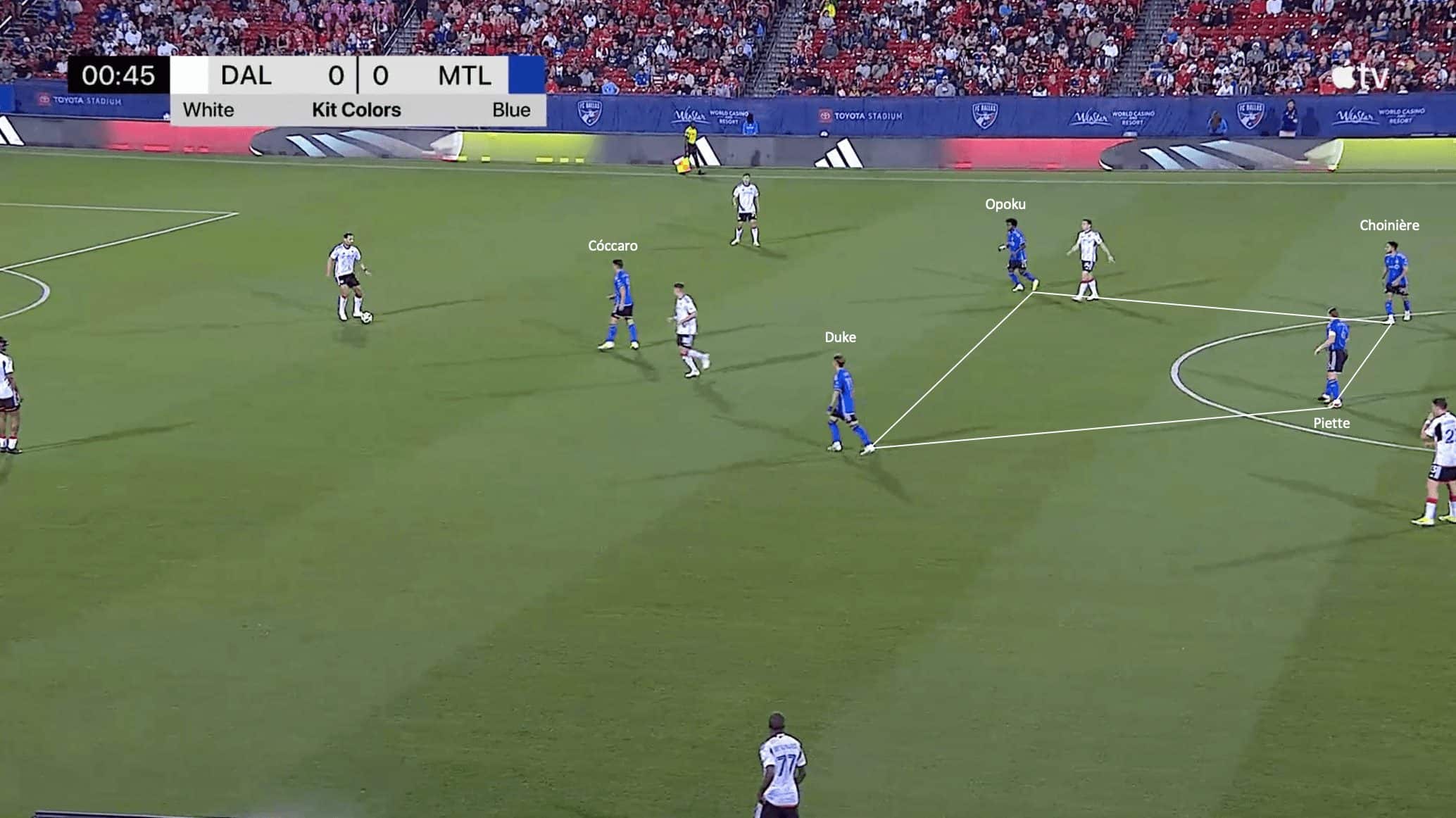
The following example shows a different type of defensive setup that Laurent Courtois opted for in the second MLS match of the season against FC Dallas. While the 45-year-old Frenchman still opted to stay with a back five formation defensively, the shape further forward was slightly altered to neutralise the chance of central progression from FC Dallas again.
As we can see from this defensive phase from the very beginning of the match, Montréal have set up in a 5-2-2-1 shape defensively, with the midfield four forming a box in midfield to prevent FC Dallas from building out from the back, their preferred style of ball progression under Nico Estévez. This midfield box forced Dallas to play to their wing-backs in the wide areas, with Montréal then looking to lock the play to one side and either force Dallas into a turnover or force them to play long into the strength of their defence.
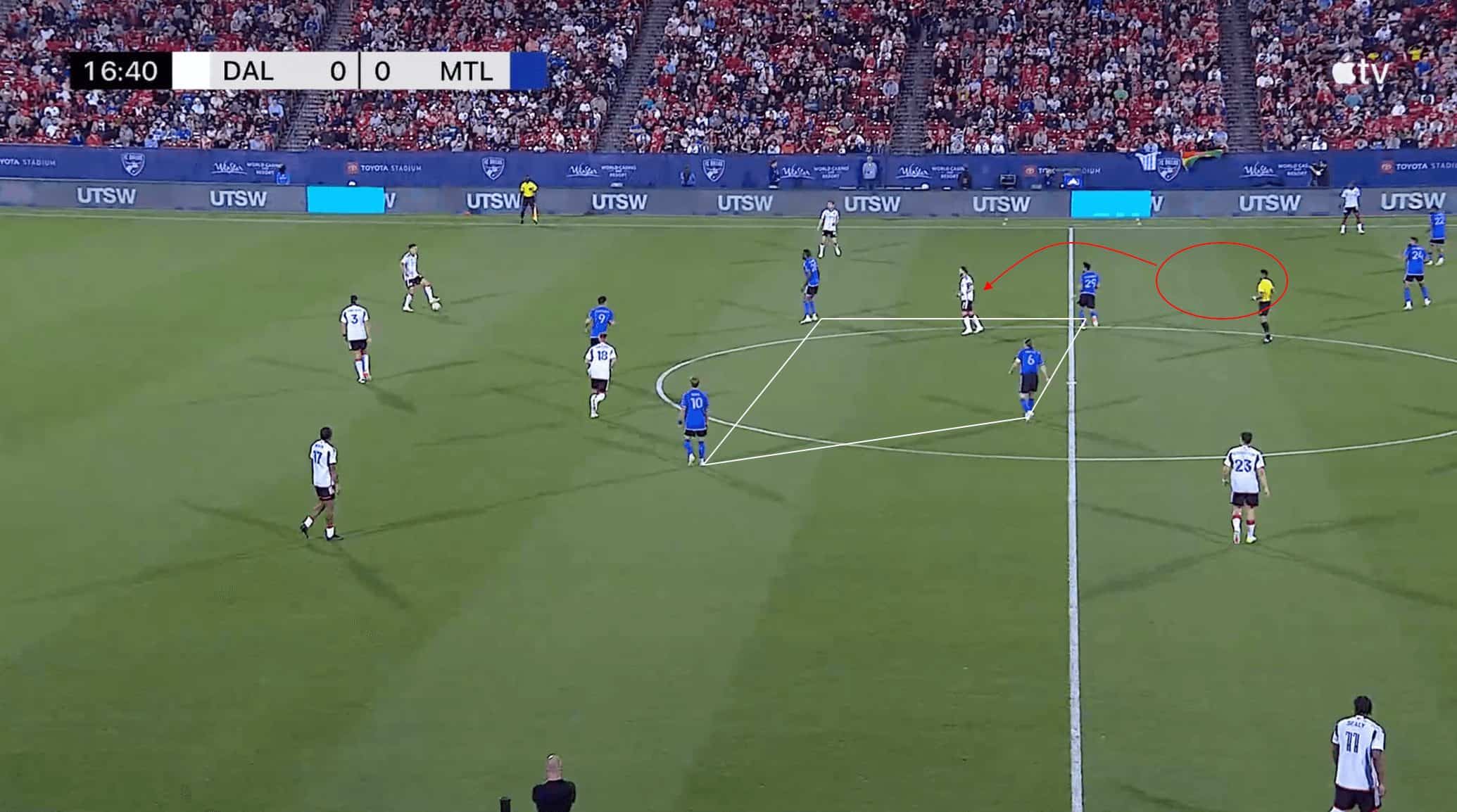
The image above shows another defensive phase of play from the same match, with the box midfield shape again preventing FC Dallas from building centrally and progressing the ball through their preferred method. In this phase of play above, the ball is in possession of one of the Dallas central defenders, with the FC Dallas midfielder dropping into a deeper position to attempt and find a pocket of space to receive possession between the Montréal lines.
However, the box shape does its trick, with the midfielder unable to be a progressive passing option for the FC Dallas defender. This forces the ball to be played either out wide or long again, with Montréal again able to regain possession and eliminate any potential attacking impetus from Dallas. As this section has been able to show, Laurent Courtois has opted to utilise low to mid block defending for the beginning of this season in charge of CF Montréal. While they have occasionally looked to be more aggressive and on the front foot at times in their first two games, a back five shape that is put together to be compact and prevent central progression has been the winning formula for Courtois so far.
Conclusion
As this tactical analysis has been able to show, Laurent Courtois has had a very good start in his first two matches of the MLS season in charge of CF Montréal. With 4 points from their opening two road games and four more in a row played on the road before their first home game at the Stade Saputo on April 13th, this has been a very positive start by the Frenchman. While CF Montréal are not the favourites in the Eastern Conference this season, the start they have had to the season will have the mood in Montréal very positive in the early stages of this MLS season.





Comments